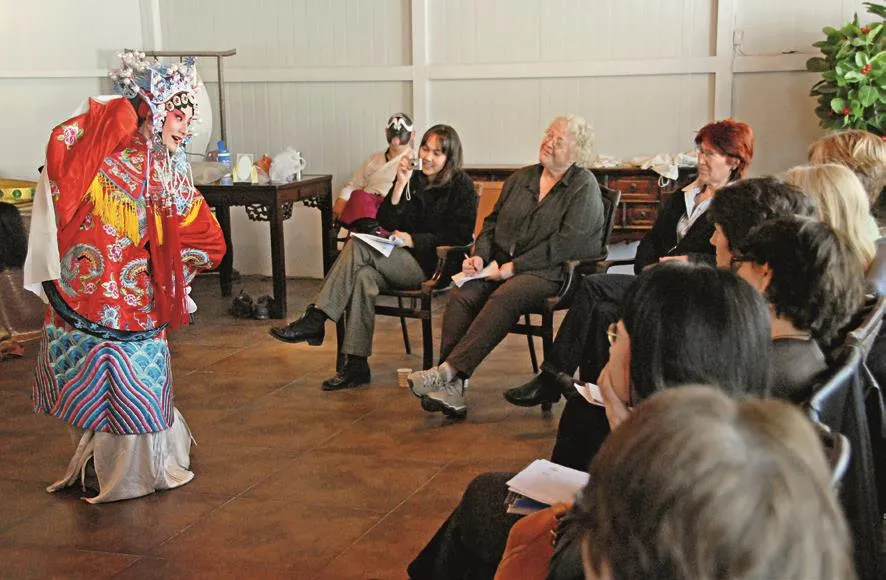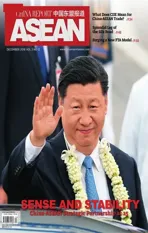TRADITION TRANSITION
2018-12-25ByHouWeili
By Hou Weili
When the College of Chinese & ASEAN Arts at Chengdu University welcomed the first class of foreign art students from ASEAN and other Belt and Road countries, the school’s Chinese theater became more diverse.
“I don’t understand the lyrics, but I can feel the male performer’s emotion and the female’s affection and caring for him from the fast tempo of their singing as well as their gestures and movements,”remarked a Thai freshman who adopted the Chinese name Yue Yongping. “It is enthralling and beautiful.”
Yue was watching a classic Peking Opera scene from The Fourth Son featuring Yu Kuizhi and Li Shengsu, both prestigious performers. The male lead is a captive Song Dynasty general attempting to persuade his wife, a princess from the hostile Liao Dynasty,to help him secretly visit his mother who is fighting Liao,unaware that her son was taken alive and forced to marry a princess of the adversary. The suggestive performances and melodious singing helped Yue overcome the linguistic barrier and understand the affectionate wife and the yearning of the male character.
Like Yue, more and more young foreigners are learning about Chinese folklore, history and contemporary life through the art of Peking Opera as people-to-people interaction between China and the world becomes more dynamic. In Southeast Asia, Peking Opera outreach is bringing myriad Asian cultures closer together.
Foundation Ties
Understanding at a personal level is the foundation of solid friendship. To this end, art exchange is helpful in sharing foreign cultures in profound ways. As the quintessence of classical Chinese culture,Peking Opera features Chinese virtues and folk conventions,which help the world understand Chinese people.“It is the epitome of Chinese aesthetics, so it is an ideal way to tell Chinese stories,” noted Yu Kuizhi.
Yuan Huiqin, vice president of National Peking Opera Company, echoed Yu in this regard, “Peking Opera represents how Chinese people sing and express emotions.It features personal stories and reveals much about perceptions of beauty and traditional mindsets.”
She explained that Peking Opera interprets philosophies on integrity, loyalty, filial piety, righteousness and benevolence—all essences of Chinese traditional culture that would be particularly beneficial for contemporary society.“These qualities compose the personal identities of hundreds of millions of Chinese people,”she added.
Chinese stories are reaching out to foreign spectators through Peking Opera, which has seen increasingly frequent theatrical performances as well as a greater volume of related lectures and literature around the world. As early as 1930, Mei Lanfang (1894-1961), one of the most famous Peking Opera artists of all time, brought his vivid work in female roles to New York spectators in the United States. The tour was such a blockbuster that performances had to be moved to a larger theater and extended from two weeks to five weeks.
Actress Sun Ping is a star who followed in Mei’s footsteps. A decade of experience promoting the art among European and U.S.people has given her great confidence in Chinese culture.“These spectators expect authentic Peking Opera,” Sun stressed, recounting audience feedback after a performance in which she adapted the singing in a failed attempt to better serve foreign tastes. “The singularity of the art is what captivates the audience.”

Foreign Peking Opera fans attend a class on the performing art organized by Chinese Culture Club in Beijing on March 7,2008.

A student from Kyrgyzstan (second left) practices Peking Opera in Liaocheng, Shandong Province, on May 7, 2015.
In between performances,she compiled a series of books in English to fill a void in the Western world of a comprehensive introduction to Peking Opera. So far, 10 volumes have been published and collected by university libraries around the world.The books include graphic illustrations of makeup,notations of music, blueprints of costumes, descriptions of vocal expressions, staging diagrams, choreography and instructions on pantomime to supplement English translations of the classical repertoire.
The spreading process has been two-way. While helping foreign art enthusiasts learn about China, Peking Opera is also incorporating Western influences. According to Mei Baojiu (1934-2016), son and successor of Chinese theater mogul Mei Lanfang, his father used to listen to bel canto music, which inspired his own productions. The trend of preserving conventionality while embracing new ideas has fueled the rise in popularity among foreigners, he said.
Passing Down the Art
Despite its lofty position in Chinese culture, Peking Opera has encountered challenges in maintaining popularity in the modern era, especially among younger audiences,due to relatively outdated performance patterns and slow rhythms. “These days, people get too stressed out from daily life and don’t like to spend a lot of time appreciating traditional art,” opined Guo Junjie, a theater aficionado from Hebei Province. “Also, there is a threshold to understand it. To really appreciate the art, you have to gain some knowledge about traditional culture.”
In response to sagging attendance, Peking Opera has attempted numerous reforms. Many troupes began to introduce modern technologies such as 3D virtual images, stereo and LED to make productions more visually appealing and cuttingedge. Mei Baojiu encouraged such innovation, but suggested they be deployed only to an appropriate degree. “Anything you add should be used to serve rather than replace the content and conventionality,”he explained.
Insiders fear the art will lose sustainable development if it fails market tests. More commercial performances are needed to attract younger fans and support its growth,asserted Zhang Jingcheng, an expert on the cultural industry.In Sun Ping’s eyes, the classroom is still the best place to expose youngsters to art and traditional culture. Today,Peking Opera is an elective course available for many primary and middle school students in China.
Facing painfully similar challenges in carrying on its traditional legacy, Thailand is also promoting its own traditional art to young people,according to Yue. He hopes to see more theater parties hosted by the university and learn more about China’s practices in preserving tradition.
